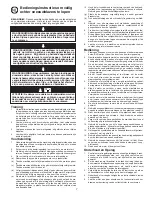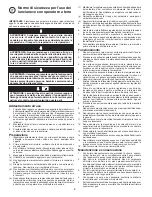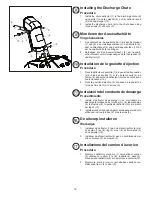
3
Safe Operation Practices for Walk-
Behind Snow Throwers
IMPORTANT:
This snow thrower is capable of amputating hands and
feet and throwing objects. Failure to observe the following safety in-
structions could result in serious injury.
WARNING: Always disconnect spark plug wire and place it
where it can not con tact plug in order to pre vent ac ci den tal
start ing when setting up, trans port ing, ad just ing or making
re pairs.
WARNING: This snow thrower is for use on side-
walks, driveways and other ground level surfaces.
Caution should be exercised while using on slop-
ing surfaces. Do not use snow thrower on surfaces
above ground level such as roofs of residences, ga-
rages, porch es or other such structures or buildings.
CAUTION: Muffler and other engine parts become ex-
tremely hot during operation and remain hot after engine
has stopped. To avoid severe burns on contact, stay away
from these areas.
WARNING: Snow throwers have ex posed rotating parts,
which can cause severe injury from contact, or from ma-
terial thrown from the discharge chute. Keep the area of
operation clear of all persons, small children and pets at
all times including startup.
Training
1. Read, understand and follow all instructions on the machine and in the
manual(s) before operating this unit. Be thoroughly familiar with the
controls and the proper use of the equipment. Know how to stop the
unit and disengage the controls quickly.
2. Never allow children to operate the equipment. Never allow adults to
operate the equipment without proper instruction.
3. Keep the area of operation clear of all persons, particularly small
children.
4. Exercise caution to avoid slipping or falling, especially when operating
the snow thrower in reverse.
Preparation
1. Thoroughly inspect the area where the equipment is to be used and
remove all doormats, sleds, boards, wires, and other foreign objects.
2. Ensure the control bar is released before starting the engine.
3. Do not operate the equipment without wearing ad e quate winter gar-
ments. Wear footwear which will improve footing on slippery surfaces.
4. Handle fuel with care; it is highly flammable.
(a) Use an approved fuel container.
(b) Never add fuel to a running engine or hot engine.
(c) Fill fuel tank outdoors with extreme care. Never fill fuel tank indoors.
(d) Never fill containers inside a vehicle or on a truck or trailer bed with a
plastic liner. Always place containers on the ground, away from your
vehicle, before filling.
(e) When practical, remove gas-powered equipment from the truck or
trailer and refuel it on the ground. If this is not possible, then refuel
such equipment on a trailer with a portable container, rather than from
a gasoline dispenser nozzle.
(f) Keep the nozzle in contact with the rim of the fuel tank or container
opening at all times, until refueling is complete. Do not use a nozzle
lock-open device.
(g) Replace gasoline cap securely and wipe up spilled fuel.
(h) If fuel is spilled on clothing, change clothing immediately.
5.
Use extension cords and receptacles as specified by the manufacturer
for all units with electric drive motors or electric starting motors.
6. Never attempt to make any adjustments while the engine (motor) is
running (except when specifically recommended by manufacturer).
7. Always wear safety glasses or eye shields during operation or while
performing an adjustment or repair to protect eyes from foreign
objects that may be thrown from the machine.
8. Let engine and machine adjust to outdoor temperatures before
starting to clear snow.
Operation
1. Do not put hands or feet near or under rotating parts. Keep clear of
the discharge opening at all times.
2. Exercise extreme caution when operating on or crossing gravel
drives, walks, or roads. Stay alert for hidden hazards or traffic.
3. After striking a foreign object, stop the engine (motor), disconnect
the cord on electric motors, thoroughly inspect the snow thrower for
any damage, and repair the damage before restarting and operating
the snow thrower.
4. If the unit should start to vibrate abnormally, stop the engine and
check immediately for the cause. Vibration is gen er al ly a warning
of trouble.
5. Stop the engine (motor) whenever you leave the operating position,
before unclogging the auger housing or discharge chute, and when
making any repairs, adjustments or inspections.
6. When cleaning, repairing or inspecting the snow thrower, stop the
engine and make certain the auger blades and all moving parts have
stopped. Remove key.
7. Do not run the engine indoors, except when starting it - and for
moving the snow thrower in or out of the building. Open the outside
doors; exhaust fumes are dangerous.
8. Exercise extreme caution when operating on slopes.
9. Never operate the snow thrower without proper guards, and other
safety protective devices in place and working.
10. Never direct the discharge toward people or areas where property
damage can occur. Keep children and others away.
11. Do not overload the machine capacity by attempting to clear snow
at too fast a rate.
12. Never operate the machine at high transport speeds on slippery
surfaces. Look behind and use care when operating in reverse.
13. Disengage power to the auger blades when snow thrower is trans-
ported or not in use.
14. Use only attachments and accessories approved by the manufacturer
of the snow thrower.
15. Never operate the snow thrower without good visibility or light. Always
be sure of your footing, and keep a firm hold on the handles. Walk;
never run.
16. Never touch a hot engine or muffler.
Maintenance and Storage
1. Check guards, shear bolts, engine mounting bolts, etc., at frequent
intervals for proper tightness to be sure the equipment is in safe
working condition.
2. Never store the machine with fuel in the fuel tank inside a building
where ignition sources are present such as hot water and space
heaters, clothes dryers, etc. Allow the engine to cool before storing
in any enclosure.
3. Always refer to owner’s guide instructions for im por tant details if the
snow thrower is to be stored for an extended period.
4. Maintain or replace safety and instructions labels, as nec es sary.
5. Run the machine a few minutes after throwing snow to prevent
freeze-up of the collector/impeller.
Summary of Contents for ST 121E
Page 67: ...67 ...
Page 68: ...08 24 2011 SR ...




































